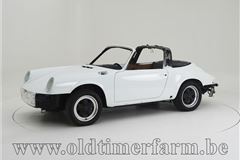Porsche 911 (1963 – 1975) Review
Porsche 911 (1963 – 1975) At A Glance
The Porsche 911 is an enduring success, which aside from a few wobbles in the late 1970s, has sold strongly throughout its life. And, yes, it's managed to turn automotive evolution on its head because the 911 remains stoutly rear-engined in a front-engined world. But its success comes down to consistant evolution.
The 911 legend started in 1963, with the car that the company would have called the 901 had Peugeot let it. But in 1964, when the 911 2.0 went on sale, it represented something of a gamble for its maker, by going upmarket, wearing a smart set of clothes styled by Butzi Porsche. The first car was powered by a new air-cooled flat-six 2.0-litre engine, nicely tuned to 130bhp, breathing through two triple-choke carbs – Solexes on early cars, then Webers from early 1966.
Since 1967, all 911s were offered in either coupe or targa-topped form, but it was the tin-top that continued to find the most buyers. From 1966, the 911 range was split into the 'cooking' versions and hotter 'S' variants. And to help with the distinction, from 1967 the regular 130bhp 911 was renamed 911L. A new entry-level 911 called the T (for Touring) with 110bhp was also introduced, giving buyers three distinctive choices (excluding the four-cylinder 912).
In August 1968, a new and lengthened B-series body was added to the range. The rear wheels moved back by 61mm to lengthen the wheelbase, add interior room and make the handling more stable. At the same time, the 911L gained fuel injection and wider wheels and became the 140bhp 911E. For 1970 ranged 'cooking' range encompassed 2.2-litres and 125/155bhp (T/E). Two years later, capacity grew to 2.4-litres and power to 130/165bhp.
The faster 911's evolution had started in 1966, with the launch of the 'S' model. It was designed with competition in mind, and boasted forged alloy pistons, vented discs, and new alloy wheels. Power output started at 160bhp in '66, but that was upped to 170bhp following the introduction of fuel injection in '69. Engine capacity grew (in parallel with the 'cooking models') to 2.2-litres in 1970, and with it came a further 10bhp - which increased again to 190bhp with launch of the 2.4-litre ‘S’ in 1971.
But the ultimate slim-bumpered 911 was yet to come. In order to continue qualifying for the sub-3.0-litre GT racing that Porsche proved so effective at, it needed to build 500 specials. These homologation specials were based on the 2.4S, but would become known as the 2.7RS. Modifications over the standard quick 911 included a big-bore engine and a programme of ruthless weight loss. Every conceivable lightening method - from thinner steel panels to throwing away the rear seats - was used in order to get the kerb weight down to less than 1000kg.
In doing so, Porsche created a magical car that's sublime to drive, and which every collector wants in their garage. The 911 2.7RS really was a race car you could drive on the road, and it was the first 911 to have wider rear wheels than fronts. In the end, and such was its success, that Porsche smashed the 500 barrier, building 200 RSLs and 1380 of the slightly softer RST models (T for Touring).

.jpg?width=640&height=426&rmode=crop)
.jpg?width=640&height=426&rmode=crop)
.jpg?width=640&height=426&rmode=crop)
.jpg?width=640&height=426&rmode=crop)
.jpg?width=640&height=426&rmode=crop)
.jpg?width=640&height=426&rmode=crop)
.jpg?width=640&height=426&rmode=crop)
.jpg?width=640&height=426&rmode=crop)
.jpg?width=640&height=426&rmode=crop)
.jpg?width=640&height=426&rmode=crop)
.jpg?width=640&height=426&rmode=crop)
.jpg?width=640&height=426&rmode=crop)


 An icon that just gets better with age
An icon that just gets better with age
 These pre-impact bumper 911s have long since stopped being an affordable bargain.
These pre-impact bumper 911s have long since stopped being an affordable bargain.


